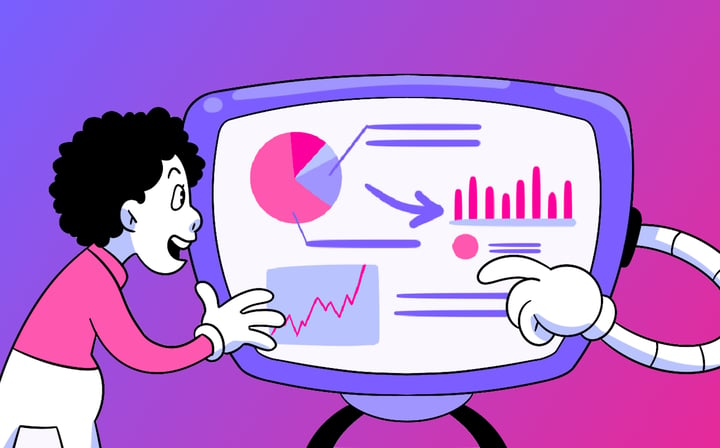Mastering IoT Analytics: Techniques, Benefits, and Challenges
Welcome to the ultimate guide to IoT analytics! In this article, we will dive deep into the world of IoT analytics, exploring its definition, importance, components, techniques, and challenges. So, let’s get started!
🔩 The Nuts and Bolts:
- IoT Analytics Extracts Valuable Insights. IoT analytics leverages data from interconnected devices to derive insights that optimize processes, enhance customer experiences, and create new revenue streams.
- Predictive Maintenance Boosts Efficiency. By analyzing sensor data, IoT analytics can predict equipment failures, helping organizations avoid costly downtime and improving operational efficiency.
- Real-Time Analytics Requires Advanced Infrastructure. Handling real-time IoT data demands scalable solutions and sophisticated algorithms to manage high-velocity streaming data for immediate insights.
- Data Security and Privacy Are Critical. Protecting IoT data from unauthorized access involves robust security measures like encryption, access controls, and secure communication protocols.
- Integration of Diverse Data Sources Is Complex. Effective IoT analytics requires integrating heterogeneous data from various devices and systems, necessitating efficient data integration platforms.
- Descriptive, Predictive, and Prescriptive Analytics Differ. Descriptive analytics summarizes past data, predictive analytics forecasts future events, and prescriptive analytics recommends actions to optimize outcomes.
Understanding IoT Analytics
Defining IoT Analytics
First things first, what exactly do we mean by IoT analytics? Well, IoT analytics refers to the process of collecting, processing, analyzing, and visualizing data generated by interconnected devices in the Internet of Things (IoT) ecosystem. It aims to derive valuable insights from this vast amount of data to make informed decisions and drive business growth.
IoT analytics involves the use of advanced technologies such as machine learning, artificial intelligence, and big data analytics to handle the sheer volume and variety of data produced by IoT devices. This data can include sensor readings, location information, user interactions, and more, providing a rich source of information for organizations to tap into.
The Importance of IoT Analytics
Why is IoT analytics so important, you may wonder? The answer lies in the fact that the IoT generates massive amounts of data that can lead to valuable insights and improved decision-making. By analyzing this data, organizations can uncover patterns, trends, and correlations that can help optimize processes, enhance customer experiences, and even create new revenue streams.
Furthermore, IoT analytics plays a crucial role in predictive maintenance, where algorithms analyze data from sensors to predict when equipment is likely to fail. This proactive approach can help organizations avoid costly downtime and maintenance, leading to increased operational efficiency and cost savings in the long run.
Build something your buyers *truly* want
Subscribe to Closing the Gap—a newsletter to help makers and doers get closer to customers. Learn more.
We believe in protecting your data. Here’s our Privacy Policy.
The Components of IoT Analytics
Data Collection in IoT
The first step in IoT analytics is data collection. With billions of devices connected to the internet, data collection becomes a complex task. Various sources, such as sensors, wearables, and smart devices, generate data continuously. Gathering this data requires scalable and efficient systems capable of handling the volume, velocity, and variety of IoT data.
In addition to sensors and wearables, other sources of IoT data include social media feeds, weather data, and geospatial information. Integrating these diverse data sources provides a comprehensive view of the IoT ecosystem, enabling organizations to make more informed decisions. Data collection mechanisms often involve edge computing, where data is processed closer to its source, reducing latency and bandwidth usage.
Data Processing and Analysis
Once the data is collected, it needs to be processed and analyzed to extract meaningful insights. This involves cleansing the data, removing any inconsistencies, and applying analytical techniques to gain a deeper understanding of the data. With the help of advanced algorithms and machine learning, organizations can uncover hidden patterns and correlations within the data that can drive business growth.
Data processing in IoT analytics often utilizes cloud computing resources to handle the massive amounts of data generated. Real-time processing and stream analytics are crucial for IoT applications that require immediate insights for decision-making. By leveraging parallel processing and distributed computing, organizations can efficiently analyze IoT data at scale.
Data Visualization in IoT Analytics
Data visualization plays a crucial role in IoT analytics. By presenting complex data in a visual format, organizations can easily interpret and communicate insights to stakeholders. Interactive dashboards, graphs, and charts enable businesses to monitor real-time data, track performance, and make data-driven decisions effectively.
Furthermore, data visualization tools in IoT analytics often incorporate geospatial mapping features to represent data points on a map. This geospatial visualization helps organizations identify patterns based on location, optimize resource allocation, and improve operational efficiency. By combining data visualization with real-time analytics, businesses can gain a competitive edge in the dynamic IoT landscape.
UX Research Methods
IoT Analytics Techniques
Descriptive Analytics
Descriptive analytics is the most basic form of IoT analytics. It involves summarizing historical data to gain insights into past events or trends. By understanding what has happened in the past, businesses can identify patterns and make informed decisions based on existing data.
For example, in the context of IoT devices tracking energy consumption in a smart home, descriptive analytics can provide a breakdown of energy usage over a specific period. This information can help homeowners understand their energy consumption patterns, identify peak usage times, and make adjustments to optimize energy efficiency.
Predictive Analytics
Predictive analytics goes a step further by using historical data to make predictions about future events or outcomes. By analyzing patterns and trends, algorithms can forecast future scenarios, enabling businesses to optimize processes, anticipate customer needs, and mitigate risks.
Continuing with the smart home energy consumption example, predictive analytics can forecast future energy usage based on historical data and external factors such as weather forecasts. This predictive capability allows homeowners to proactively adjust their energy usage to avoid peak pricing periods or reduce overall consumption.
Prescriptive Analytics
The most advanced form of IoT analytics is prescriptive analytics. It not only predicts future outcomes but also recommends actions to optimize those outcomes. By leveraging complex algorithms and machine learning models, prescriptive analytics helps organizations make proactive decisions to achieve desired results.
Building on the smart home energy consumption scenario, prescriptive analytics can not only predict future energy usage but also recommend specific actions to minimize costs or reduce environmental impact. For instance, the system could suggest adjusting thermostat settings during certain hours or investing in energy-efficient appliances to achieve long-term savings.
Challenges in IoT Analytics
Data Security and Privacy
With the increasing volume of IoT data, ensuring data security and privacy becomes a significant challenge. Organizations must implement robust security measures to protect sensitive information. Encryption, access controls, and secure communication protocols are essential to safeguard IoT data from unauthorized access and potential breaches.
One of the key concerns in data security for IoT analytics is the vulnerability of connected devices. These devices, ranging from smart home appliances to industrial sensors, can be susceptible to cyber attacks. Hackers can exploit vulnerabilities in the devices’ firmware or software to gain unauthorized access to the data they collect. To mitigate this risk, organizations must regularly update and patch the firmware of their IoT devices, as well as implement strong authentication mechanisms to prevent unauthorized access.
Moreover, data privacy is another critical aspect of IoT analytics. As IoT devices collect vast amounts of data from individuals, organizations must ensure that they comply with relevant privacy regulations, such as the General Data Protection Regulation (GDPR). This involves obtaining explicit consent from users before collecting their data, providing transparency in data usage, and implementing data anonymization techniques to protect individuals’ identities.
Data Integration
IoT analytics often involves working with heterogeneous data from various sources. Integrating and harmonizing this data can be a complex task. Organizations need to develop efficient data integration platforms to consolidate data from different devices and systems, enabling seamless analysis and decision-making.
One of the challenges in data integration for IoT analytics is the lack of standardized protocols and formats for data exchange. Different IoT devices and systems may use different communication protocols and data formats, making it difficult to integrate and analyze the data. To address this challenge, organizations can adopt industry standards, such as the Message Queuing Telemetry Transport (MQTT) protocol, which provides a lightweight and efficient way to exchange data between IoT devices and systems.
In addition, data quality is another important consideration in data integration for IoT analytics. The data collected by IoT devices may be noisy, incomplete, or inconsistent, which can affect the accuracy and reliability of the analysis. Organizations need to implement data cleansing and data validation techniques to ensure the quality of the integrated data, such as outlier detection and data imputation algorithms.
Real-time Analytics
In the world of IoT, real-time analytics is crucial to extract immediate insights and take prompt actions. However, handling and processing real-time data requires powerful infrastructure and sophisticated algorithms to accommodate the high velocity and volume of streaming data. Organizations need to invest in scalable and real-time analytics solutions to harness the full potential of IoT data.
One of the challenges in real-time analytics for IoT is the latency in data processing. Traditional analytics systems may not be able to handle the high-speed data streams generated by IoT devices, resulting in delays in data analysis and decision-making. To overcome this challenge, organizations can leverage technologies such as edge computing, which brings the analytics closer to the data source, reducing the latency and enabling real-time insights.
Furthermore, real-time analytics requires advanced analytics techniques to handle the complexity and variability of IoT data. Machine learning algorithms, such as anomaly detection and predictive modeling, can be applied to real-time IoT data to identify patterns, detect anomalies, and make accurate predictions. Organizations need to invest in data scientists and data engineers with expertise in real-time analytics to develop and deploy these advanced analytics models.
In conclusion, the challenges in IoT analytics are multifaceted and require careful consideration and planning. By addressing the issues of data security and privacy, data integration, and real-time analytics, organizations can unlock the full potential of IoT data and gain valuable insights for informed decision-making. Embracing these challenges and investing in the right technologies and expertise will enable organizations to thrive in the data-driven world of IoT analytics.
IoT analytics FAQs
IoT analytics refers to the process of collecting, processing, analyzing, and visualizing data generated by interconnected devices in the Internet of Things (IoT) ecosystem. It uses advanced technologies like machine learning and big data analytics to derive valuable insights from IoT data.
IoT analytics is crucial because it transforms massive amounts of data from IoT devices into actionable insights. These insights can optimize processes, improve customer experiences, enhance predictive maintenance, and create new revenue streams, driving overall business growth.
The main components of IoT analytics are data collection, data processing and analysis, and data visualization. These components work together to gather, clean, analyze, and present data in a way that stakeholders can understand and use to make informed decisions.
IoT analytics handles data security and privacy by implementing robust measures such as encryption, access controls, and secure communication protocols. These measures protect sensitive information from unauthorized access and potential breaches, ensuring the integrity and confidentiality of IoT data.
IoT analytics employs techniques such as descriptive analytics to summarize past data, predictive analytics to forecast future events, and prescriptive analytics to recommend actions. These techniques help organizations understand trends, predict outcomes, and make proactive decisions.
Challenges in IoT analytics include ensuring data security and privacy, integrating heterogeneous data from various sources, and handling real-time data. These challenges require robust security measures, efficient data integration platforms, and scalable real-time analytics solutions.
Organizations can benefit from IoT analytics by gaining insights that optimize operations, enhance customer experiences, and drive innovation. Predictive maintenance, real-time decision-making, and improved resource allocation are some of the key benefits that can lead to increased efficiency and cost savings.



